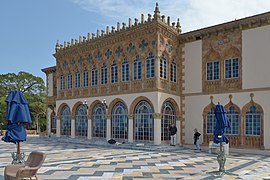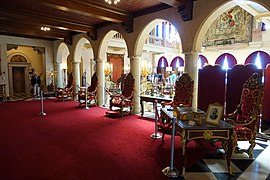Ca' d'Zan
This article has multiple issues. Please help or discuss these issues on the talk page. (Learn how and when to remove these template messages)
|
Ca' d'Zan | |
 Cà d'Zan - the bay front façade of the living room on the western elevation and marble terrace | |
 | |
| Location | Sarasota, Florida |
|---|---|
| Coordinates | 27°22′58.5″N 82°33′52.5″W / 27.382917°N 82.564583°WCoordinates: 27°22′58.5″N 82°33′52.5″W / 27.382917°N 82.564583°W |
| Architectural style | Mediterranean revival style |
| Part of | Caples'-Ringlings' Estates Historic District (ID82001039[1]) |
| Designated CP | 15 December 1982 |
Ca' d'Zan is a Mediterranean revival style residence in Sarasota, Florida, adjacent to Sarasota Bay. The winter residence of circus mogul, capitalist, entrepreneur and art collector John Ringling and his wife Mable has been admired as an architectural gem since it was completed in 1926.
Description and history[]

The Ringlings first came to Sarasota in 1909 and purchased their waterfront estate in 1911. They wintered at Palms Elysian, an existing house on the property built in 1895, for over a decade before they commissioned the architect Dwight James Baum to design a new winter residence. Construction began in 1924, and the residence was completed in 1926. The Mediterranean revival style home features an eclectic array of stylistic influences, including Venetian Gothic, Italian Renaissance, Moorish, and Spanish-inspired elements drawn from different historic periods. The Venetian Gothic influence is prominently seen in a variety of architectural elements in the decorative program, such as windows with Gothic arches and terra cotta ornament replicating Gothic tracery. Highly evocative of the architecture of Venice, Italy, where the Ringlings visited on their trips to Europe, the name of the residence, Ca' d'Zan, is Venetian dialect for House of John. Soon after its completion, Ca' d'Zan garnered national attention and was even called "A Venetian Palace in Florida" when featured in Country Life magazine in 1927.[2] As an expression of revivalist architecture, the array of decorative details that ornament Ca' d'Zan's façade were drawn from different cultural and historic eras in European architecture. As such, the residence is ultimately an imaginative pastiche, uniquely American in character, given its fanciful and creative synthesis of historicizing details.

Ca' d'Zan was meant to impress as a showplace for entertaining. Its first floor consists of principal rooms for entertaining, including a Reception Room, Lounging Room, Breakfast Room, Dining Room, Great Hall and Ballroom. The Ringlings commissioned the artist and designer, Willy Pogany (American, born Hungary, 1882-1955), to paint murals for Ca' d'Zan's elaborate interiors. In the Ballroom, 26 canvas paintings are inset into the gilt, coffered ceiling that depict "Dancers of the Nations." This unique ceiling mural reflects the broader trend in high-style American interior design for cosmopolitanism. It was fashionable for wealthy patrons to commission themed decoration to show how cosmopolitan they were. The dancers depicted range from ancient cultures to a range of modern European folk dances, as well as dances from non-Western cultures. The grandeur of the ballroom ceiling mural reflects the Ringlings' ambitions to impress guests with their knowledge of cultures from around the world; however a number of the cultures depicted may be viewed as imagined cultural stereotypes today. Additionally, Willy Pogany also painted a ceiling mural for the 3rd floor playroom that depicts scenes from festivities surrounding Venetian Carnivale. This mural includes a fanciful portrait of John and Mable Ringling in festive attire and surrounded by a menagerie of pets, including their dogs and exotic birds. Another artist, Robert Webb Jr., was hired to paint decorative details throughout the home, including painting Italianate ornament on the ceiling in the Dining Room, floral and foliate ornament on the ceiling of the Reception Room, as well as colorful Venetian-inspired ornament on the pecky cypress ceiling in the Great Hall.
The Ringlings purchased many antiques and furnishings at auctions of Gilded Age estates. As such, much of the ornate, revival style decor of Ca' d'Zan may be viewed as an homage to the Gilded Age.
After Mable Ringling died in 1929, John Ringling continued to visit Ca' d'Zan until his death in 1936. Ca' d'Zan was part of John Ringling's bequest to the state of Florida, along with The John & Mable Ringling Museum of Art, which was meant to be a memorial art museum and their philanthropic legacy. However, the estate was in limbo for ten years, as it took a long time to settle debts, claims by heirs, and taxes before the State of Florida could take control of the property. Unfortunately, Ca' d'Zan was uninhabited from 1936 to 1946, and the home deteriorated during that time with a lack of interior climate control. Ca' d'Zan opened to the public in 1946 as part of the State Art Museum of Florida. On opening day, thousands of visitors lined up to walk through the house that John and Mable Ringling built. Ca' d'Zan's fame grew as a popular roadside tourist attraction and continues to fascinate the public to this day.
In 1982, the residence was listed as a contributing property to the Caples'-Ringlings' Estates Historic District, which is on the National Register of Historic Places.[1] Other contributing properties in the district include the Ellen and Ralph Caples residence, The John & Mable Ringling Museum, the Hester Ringling Lancaster Sandford residence, and the Edith and Charles Ringling residence. On April 18, 2012, the AIA's Florida Chapter placed Ca' d'Zan, the Residence of John and Mable Ringling on its list, Florida Architecture: 100 Years. 100 Places.[3]
The 1998 film Great Expectations, directed by Alfonso Cuarón, had portions filmed at Ca' d'Zan, which served as Ms. Dinsmoor's house, Paradiso Perduto.
The polychrome architectural terra cotta that gives Ca' d'Zan its distinctive façade was originally produced by O.W. Ketcham Terra Cotta Works, based in Crum Lynne, PA. Over the years, elements of terra cotta have been reproduced, including sections made by O.W. Ketcham Terra Cotta in the 1950s. The residence is a rare survival and glamorous icon of the Florida Boom Years of the 1920s, for which John Ringling played a major role as a real estate developer in Sarasota. Ca' d'Zan underwent a major restoration from 1996 to 2002 that cost $15 million dollars. The swimming pool was restored in 2018 and is now a shallow reflecting pool. Historic preservation is ongoing to maintain the nearly 100-year old home for future generations to enjoy.[4]
Gallery[]


Ringling Museum Cà d'Zan

Ringling Museum Cà d'Zan

Entrance foyer

Court
References[]
- ^ a b "National Register Information System – Caples'-Ringlings' Estates Historic District (#82001039)". National Register of Historic Places. National Park Service. 13 March 2009.
- ^ Sears, Roger F. "A Venetian Palace in Florida". Country Life. (October 1927) 52: 34–40.
- ^ "AIA Florida Top 100 Buildings". aiaflatop100.org. Retrieved 2012-11-18.
- ^ Hershon, Marissa, and Barbara Ramsay (2020). ""Preservation Projects at Ca' d'Zan"". Ringling Magazine. Oct-Dec 2020: 6–7.
External links[]
| Wikimedia Commons has media related to Cà d'Zan. |
- Historic district contributing properties in Florida
- Houses completed in 1926
- Houses in Sarasota, Florida
- Italianate architecture in Florida
- Mediterranean Revival architecture in Florida
- National Register of Historic Places in Sarasota County, Florida







